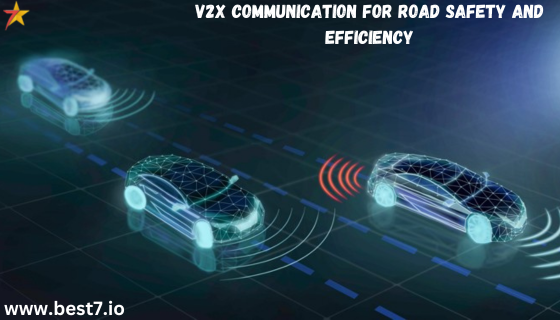
Over recent years, Vehicle-to-Everything (V2X) communication technology has emerged as a potential game-changer in the automotive industry. It promises to revolutionize road safety and traffic efficiency by enabling vehicles to communicate not only with each other but also with infrastructure, pedestrians, and the cloud. With cities around the world increasingly adopting smart infrastructure, V2X communication is showing significant promise in improving road safety and traffic flow.
The Importance of V2X Communication
V2X communication technology is widely regarded as essential in the development of connected vehicles. The connected vehicle market is anticipated to grow substantially, driven by the increasing role of this technology in the automotive industry. V2X communication is expected to transform how vehicles interact with their surroundings, leading to enhanced safety and more efficient roadways.
Ensuring Road Safety with V2X Communication
A primary goal of V2X communication is to enhance road safety. By enabling real-time communication among vehicles, potential hazards can be anticipated and avoided. According to the National Highway Traffic Safety Administration (NHTSA), V2X communication could potentially reduce traffic accidents by 80%, saving thousands of lives annually.
Boosting Traffic Efficiency
V2X technology also aims to optimize traffic flow, maximizing efficiency on the road. By sharing real-time information on traffic conditions, signal timings, and possible delays, V2X enables drivers to make better-informed decisions. Studies show that V2X communication could lead to travel time savings of up to 15%, substantially improving daily commutes.
Key Elements of V2X Communication Technology
V2X communication comprises several elements that contribute to road safety and traffic efficiency.
Vehicle-to-Vehicle (V2V) Communication
V2V communication allows vehicles to share data on speed, direction, and braking status directly with each other, helping prevent collisions. Research indicates that V2V technology could potentially prevent 57% of rear-end collisions.
Vehicle-to-Infrastructure (V2I) Communication
V2I communication enables data exchange between vehicles and transport infrastructure, such as traffic signals and road hazard warnings. It enhances traffic flow by providing vehicles with updated information on road conditions, which could reduce delays by 30%, according to IEEE.
Vehicle-to-Pedestrian (V2P) Communication
V2P technology enhances pedestrian safety by alerting vehicles to the presence of pedestrians and cyclists, reducing accidents. The European Commission estimates that V2P communication could prevent 20% of pedestrian fatalities in Europe.
Advancing Smart Infrastructure with V2X Technology
The success of V2X communication depends largely on smart infrastructure development.
Connected Traffic Signals
V2X-enabled traffic signals can adjust timings based on real-time traffic conditions, helping reduce intersection wait times and improve flow. Research shows that connected signals can cut delays by 25%.
Roadway Sensors
Road sensors gather data on traffic patterns and road conditions, which can improve traffic management and potentially prevent 15% of traffic incidents.
Integration with Smart Cities
Integrating V2X communication with smart city projects is crucial for a more connected and efficient transportation network. A Gartner study suggests that V2X communications solutions will be implemented in half of the world’s cities within five years.
The Role of V2X in Self-Driving Vehicles
V2X communication is fundamental to the advancement of autonomous vehicles, enhancing their safety and operational efficiency.
Improved Sensor Data for Autonomous Vehicles
By integrating V2X with sensor data, autonomous vehicles gain real-time information on traffic flow and hazards, increasing their accuracy by up to 30%.
Facilitating Cooperative Driving
V2X communication enables cooperative driving, where vehicles communicate to make smart decisions in complex traffic scenarios. Research shows this can alleviate traffic congestion by up to 40%.
Regulatory Compliance
As autonomous vehicles become more prevalent, regulatory frameworks need to adapt to V2X technology. Governments are working on regulations to ensure the security and efficacy of V2X systems, led by organizations like the NHTSA.
The Future of V2X Communication
With ongoing advancements, the future of V2X communication is promising, holding potential for further enhancements in road safety and traffic management.
The Impact of 5G Technology
The rollout of 5G technology is expected to amplify V2X productivity by providing rapid data transfer speeds and low latency, enhancing responsiveness to potential hazards.
Unlocking Insights Through Data
Data from V2X communication can provide valuable insights for urban planning, helping cities address infrastructure needs and optimize traffic flow.
Building Consumer Acceptance
Public acceptance and trust are vital for widespread V2X adoption. Educational campaigns are essential to increase awareness of the technology’s benefits, as shown by AAA’s finding that 72% of drivers are open to using connected vehicle technologies.
Collaborating Among Key Stakeholders
The success of V2X technology depends on collaboration among automakers, technology providers, government agencies, and urban planners. Public-private partnerships are key to accelerating the development and deployment of V2X systems, as highlighted by the World Economic Forum.
A Revolution in Road Safety and Efficiency
V2X communication technology has the potential to transform transportation by improving road safety and traffic flow. As cities and automakers adopt V2X systems, this technology paves the way for a safer, more connected, and environmentally friendly future in transportation.












